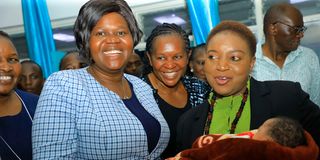Drive to prevent HIV transmission from mothers to babies

Health Cabinet Secretary Susan Nakhumicha (right) and Homa Bay Governor Gladys Wanga at Homa Bay County Teaching and Referral Hospital during the launch of the National Plan to Eliminate AIDS in Children by 2027 on September 8,2023
What you need to know:
- According to data from the National AIDS and STI Control Programme, over 4,500 children aged 0-14 acquired HIV, mostly associated with mother-child transmission, last year.
- The problem emanates from pregnant mothers who deliver at home, thus they can’t get services of qualified health workers, and this increases the chances of transmission during birth.
The Ministry of Health has embarked on an awareness creation campaign in an effort to reduce increasing HIV infections among children.
The drive, which was launched in Homa Bay County, aims to promote skilled delivery. The ministry will work with community health volunteers to sensitise residents on the need to deliver in equipped health facilities.
Homa Bay leads in HIV prevalence at 19.6 per cent, which is four times the national average of 4.9 per cent.
The county is closely followed by Kisumu (17.5 per cent), Siaya (15.3 per cent) and Migori (13 per cent), according to the 2018 Kenya Population-Based HIV Impact Assessment report.
According to Health Cabinet Secretary CS Susan Nakhumicha, the awareness drive is in line with Kenya’s plan to end HIV infection among children in the next four years.
“We will empower community health volunteers to educate women about the significance of skilled delivery. This will prevent HIV positive mothers from infecting their babies,” said CS Nakhumicha.
The CS was speaking during the Kenya Plan to End AIDS in Children by 2027 strategy launch in Nyanza.
This comes at a time when the country has been recording a rise in the number of HIV cases among newborns.
According to data from the National AIDS and STI Control Programme, over 4,500 children aged 0-14 acquired HIV, mostly associated with mother-child transmission, last year.
Ms Nakhumicha said the problem emanates from pregnant mothers who deliver at home, thus they can’t get services of qualified health workers, and this increases the chances of transmission during birth.
Transmission of HIV from mothers to their newborns is considered one of the greatest health challenges and remains an impediment in the war against HIV in the country.
“With the efforts we are making, mortality deaths will drop significantly. We want to ensure that all expectant women get the best care when they go to hospital,” said Homa Bay Governor Gladys Wanga.
She said her government has upgraded five hospitals with modern maternity wings for enhancing the fight against transmission of HIV from mothers to babies.
According to the Ministry of Health, without antiretroviral treatment, one third of children who are infected with the virus after birth die within one year. Approximately 50 per cent of untreated HIV‐positive infants die by the age of two years
But according to health experts, taking HIV medicine and maintaining an undetectable viral load during pregnancy, labor and delivery and while breast/chestfeeding reduces the chances of transmission .






